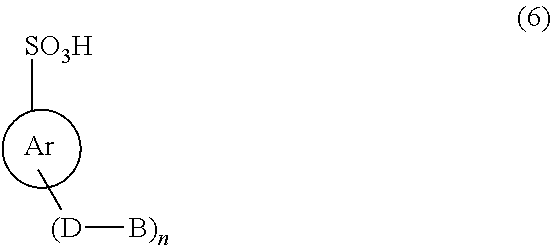Actinic-ray- or radiation-sensitive resin composition and method of forming pattern using the composition
a technology of radiation-sensitive resin and composition, which is applied in the direction of photosensitive materials, instruments, photomechanical equipment, etc., can solve the problems of unsatisfactory above-mentioned chemical amplification systems, unsatisfactory acid generators in many respects, and serious roughness characteristics and resolution
- Summary
- Abstract
- Description
- Claims
- Application Information
AI Technical Summary
Benefits of technology
Problems solved by technology
Method used
Image
Examples
example
[0523]The present invention will be described in greater detail below by way of its examples. However, the gist of the present invention is in no way limited to these examples.
[0524]
[0525][Synthesis]
[0526]Compounds 1 to 16 shown in Table 1 below were synthesized as sulfonic acid-generating compounds in the following manner. Further, for control, comparative compounds 1 to 5 were synthesized in the following manner.
[0527]
TABLE 1Vol. of generatedCompd.Structure of compd.acid (Å3) 1303 2437 3244 4266 5380 6311 7244 8271 930310303113031230313303143031530316303Comparative compound 1186Comparative compound 2216Comparative compound 3186Comparative compound 4186Comparative compound 5172
[0528](Synthesis of Compound 1)
[0529]Alcohol of the formula below (3.9 g, 20.1 mmol), 30 ml of methylene chloride and triethylamine (7.8 g, 77.5 mmol) were mixed together.
[0530]
[0531]Subsequently, triisopropylbenzenesulfonyl chloride (6.1 g, 20.2 mmol) and dimethylaminopyridine (98.1 g, 0.8 mmol) were added t...
example a
Examples 1A to 11A and Comparative Examples 1A to 6A
[0576](Preparation of Resist)
[0577]Referring to Table 2 below, individual components were dissolved in solvents, thereby obtaining solutions each of 4.0 mass % solid content. Each of the solutions was passed through a polytetrafluoroethylene filter of 0.1 μm pore size, thereby obtaining a positive resist solution.
[0578](Evaluation of Resist)
[0579]An antireflection film DUV-42 produced by Brewer Science Inc. was uniformly applied at a thickness of 60 nm onto a silicon substrate having undergone a hexamethyldisilazane treatment by means of a spin coater, and dried on a hot plate at 100° C. for 90 seconds. Further drying was carried out by heating at 190° C. for 240 seconds. Thereafter, each of the positive resist solutions was applied thereonto by means of a spin coater and dried at 120° C. for 90 seconds, thereby obtaining a 0.12 μm-thick resist film.
[0580]The obtained resist film was exposed through a mask by means of an ArF excime...
example b
[0598]A resist solution was prepared according to the same procedure as in Example A except that 0.06 g of the polymer shown below was added to the composition of Example 1A. The resist solution was applied in the same manner, thereby obtaining a resist film. The obtained resist film was patternwise exposed through an immersion liquid (pure water) by means of an ArF excimer laser liquid-immersion scanner (manufactured by ASML, XT1250i, NA 0.85), and a pattern was formed in the same manner as in Example A. It was ascertained that in all of the sensitivity, resolution (γ), roughness characteristic, shape of pattern and aging stability, the same evaluation results were obtained on the obtained pattern.
[0599]
[0600]wt. av. MW 4500, dispersity 1.4
PUM
| Property | Measurement | Unit |
|---|---|---|
| temperature | aaaaa | aaaaa |
| optical purity | aaaaa | aaaaa |
| optical purity | aaaaa | aaaaa |
Abstract
Description
Claims
Application Information
 Login to View More
Login to View More - R&D
- Intellectual Property
- Life Sciences
- Materials
- Tech Scout
- Unparalleled Data Quality
- Higher Quality Content
- 60% Fewer Hallucinations
Browse by: Latest US Patents, China's latest patents, Technical Efficacy Thesaurus, Application Domain, Technology Topic, Popular Technical Reports.
© 2025 PatSnap. All rights reserved.Legal|Privacy policy|Modern Slavery Act Transparency Statement|Sitemap|About US| Contact US: help@patsnap.com



